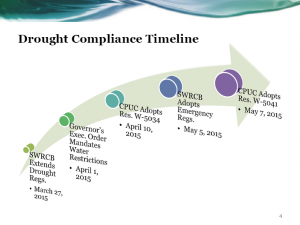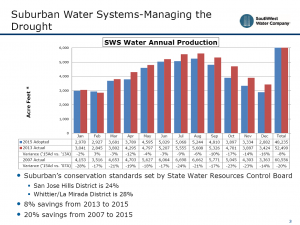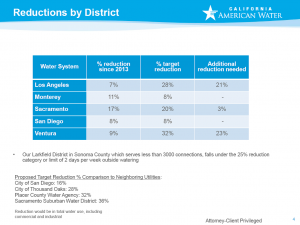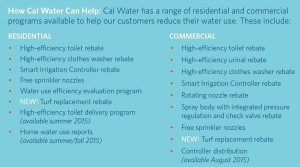The California Water Association’s (CWA) 2015 Spring Conference in Sacramento in mid-May drew water industry experts and regulators from across the state to share their thoughts on the how regulated water utilities are juggling multiple priorities. CWA President Greg Milleman, Director of Finance and Field Administration at California Water Service, welcomed the conference attendees and enumerated these priorities:
- The State Water Resources Control Board’s (SWRCB) emergency drought regulations;
- The California Public Utilities Commission’s (CPUC) accompanying resolutions on compliance with the SWRCB, including restrictions, penalties and surcharges surrounding implementation of the drought emergency plans;
- Compliance with the new statewide drinking water discharge permit;
- Compliance with the new “Sustainable Groundwater Management Act (SGMA);
- The ongoing water quality challenges;
- The pending water and CPUC “transparency” legislation;
- The new CPUC rulemaking on conservation rates and drought management; and
- The ongoing infrastructure and customer service obligations.

In his opening keynote address, Assembly Member Marc Levine (D-San Rafael), chair of the Assembly Water, Parks and Wildlife Committee, discussed the various pieces of legislation his committee addressed this spring, including SGMA. Of particular note, he said CPUC-regulated water utilities should be members of the Groundwater Sustainability Agencies envisioned by SGMA and fully participate in the development of the requisite Groundwater Sustainability Plans.
Evan Jacobs, External Affairs Manager, California American Water, moderated the first panel on “Managing the Investor-Owned Water Utilities’ (IOUs’) Role in Groundwater Sustainability Agencies.” Panelists included Alfred Smith, Partner, Nossaman LLP; Toby Moore, Water Resources Manager and Chief Hydrogeologist, Golden State Water Company (GSWC); and Trevor Joseph, Supervising Engineering Geologist, California Department of Water Resources (DWR). The panel members covered the major points and requirements of SGMA, the role of DWR vis-à-vis the SWRCB and how water IOUs plan to address the statute’s provisions that will handicap IOUs.
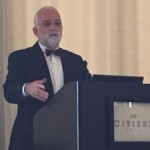
The panel on “Complying with the New Drinking Water Discharge Permit” was moderated by Diana Messina, Supervising Engineer, SWRCB, with panelists Brandy Hancocks, Manager of Environmental Compliance, GSWC; and Francois Rodigari, Director of Water Quality and Environmental Services, San Jose Water Company (SJWC). Messina summarized the new discharge permit, and Rodigari and Hancocks described their companies’ compliance plans.
Rami Kahlon, Director, CPUC Division of Water and Audits, moderated the panel on “Managing the Drought – Where the Water IOUs Are Today.” Panelists included Bob Di Primio, Vice President, San Gabriel Valley Water Company (SGVWC); Jeff Linam, Vice President of Rates, California American Water (CAW); Paul Townsley, Vice President, Regulatory Matters and Corporate Relations, California Water Service (Cal Water); and Richard Rich, General Manager, Suburban Water Systems (Suburban).

Kahlon provided a timeline of California’s drought from 2007 to the CPUC’s recent resolutions directing compliance with the SWRCB’s drought regulations. He attributed the state’s Water Action Plan (WAP) as a contributing factor to the IOUs being better prepared to meet mandates compared with public agencies. The four company panelists all previewed plans for implementing their Water Shortage Contingency Plans contained in their Tariff Rule/Schedules 14.1, which are in the process of being activated.
Below are some of the charts the panelists included during their presentations to illustrate their companies’ varying situations:
(Click image to expand.)

SWRCB Member DeeDee D’Adamo addressed the new emergency conservation regulations in her luncheon presentation titled “Managing the Tightening (Drought) Noose.” D’Adamo noted that the governor’s 25 percent statewide reduction in potable urban water use will result in a savings of 1.3 million acre-feet during the next nine months – the current amount of water in Lake Oroville. She outlined existing and new requirements for water suppliers and their customers as well as next steps for the SWRCB. These include working with water suppliers and others on rates, supporting incentive-based programs, such as appliance rebates and turf-removal programs, and tracking compliance through monthly reporting. Noting that the CPUC ordered all IOUs to implement the most dramatic rate plans and tiers (refer to illustration) with voluntary to mandatory water-use restrictions, D’Adamo concluded by noting the need for collaboration and that the SWRCB is looking to the IOUs for feedback on implementation of the new regulations.
 Following lunch, Jack Hawks moderated a panel on “Dealing with Customer Concerns – Drought, Conservation and Rates.” Hawks noted the water IOUs are doing their part to implement the CPUC’s Schedule 14.1, the mandatory water shortage/reduction program. Joining Hawks on the panel were Kevin Tilden, Vice President of External Affairs, CAW; John Tang, Vice President, Government Relations and Corporate Communications, SJWC; Yvonne Kingman, Corporate Communications Manager, Cal Water; and Christine Kohn, Principal, IN Communications, and CWA’s outside communications consultant.
Following lunch, Jack Hawks moderated a panel on “Dealing with Customer Concerns – Drought, Conservation and Rates.” Hawks noted the water IOUs are doing their part to implement the CPUC’s Schedule 14.1, the mandatory water shortage/reduction program. Joining Hawks on the panel were Kevin Tilden, Vice President of External Affairs, CAW; John Tang, Vice President, Government Relations and Corporate Communications, SJWC; Yvonne Kingman, Corporate Communications Manager, Cal Water; and Christine Kohn, Principal, IN Communications, and CWA’s outside communications consultant.
The IOU panelists summarized their outreach efforts to customers, including both traditional media, such as advertising, direct mail, bill inserts, etc., as well as new approaches like email blasts, social media and mobile applications, including the Nextdoor app, a private social network for neighborhoods. Among the most significant challenges were the need to address customer confusion about the conflicting water-use reduction mandates, fines and outdoor water schedules issued by the governor and state and local water regulators. To dispel that confusion, company home webpages include clear and concise drought and conservation information and updates as well as a “report water waste” button. Also, company conservation coordinators have reached out to local officials, businesses and high-use residential customers and provided table tents and mirror stickers to restaurants and hotels/motels.
Kohn exhorted the companies to use the most effective “calls-to-action” such as limiting showers to five minutes, checking for leaks and planting low-water-use plants. She also suggested developing a regional information hub and citing best practices and third parties to lend credibility to messaging, including the governor and state regulatory agencies. Finally, Kohn urged water companies to document everything and demonstrate what they’ve done and are doing through social media, billboards, print ads and direct mail.
Following the panel discussion, Robb Barnitt, Founder and Chief Executive Officer, Dropcountr, presented his company’s digital technology for water conservation, which connects customers and their utilities on mobile devices to help save water, money and time.
The final panel of the day, moderated by Jennifer Capitolo, Senior Policy Advisor, Nossaman LLP, centered on “Working the 2015 Legislative Session.” The panelists included Tina Cannon Leahy, Principal Consultant, Assembly Water, Parks and Wildlife Committee; Danielle Blacet, Director for Water, California Municipal Utilities Association; Kathleen Cole, Executive Legislative Representative, Metropolitan Water District of Southern California; Wendy Ridderbusch, Director of State Relations, Association of California Water Agencies; and Jennifer West, Managing Director, WateReuse California. The principal discussion topics were the Sustainable Groundwater Management Act, the rollout of the Proposition 1 funds for various water supply and drought management programs and the SWRCB’s proposed legislation for changing the fee structure for the state’s Drinking Water Program.



